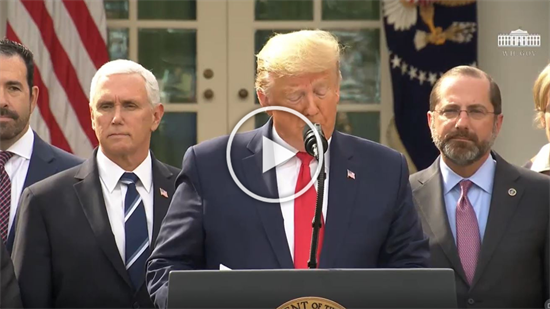|
On Friday, March 13, 2020, President Trump declared a national emergency under provisions of the Stafford Disaster Relief and Emergency Assistance Act of 1988 (Stafford Act), which will deliver meaningful relief for state and local governments to control and prevent the spread of COVID-19. The announcement also included the elimination of certain burdensome laws and regulations, giving doctors and hospitals “maximum flexibility” to provide quality care for patients. Provisions from the emergency declaration and its accompanying executive actions include:
| Mobilizing Federal Resources to Combat the Coronavirus |
- An additional $42 billion in funding for states to combat the coronavirus.
- Authorization for the Small Business Administration to make available $7 billion in loans to qualifying small businesses to assist economic recovery.
- The Centers for Medicare and Medicaid Services has announced guidance to limit medically unnecessary visits to nursing homes to protect vulnerable elderly Americans.
- The Secretary of the Education will be waiving interest on all student loans held by the Federal Government.
- The President is directing the Department of Energy to purchase large quantities of crude oil for the strategic reserve.
- The President is urging every State to set up emergency operational centers and is asking every hospital to activate its emergency preparedness plan.
|
| Empowering Health Care Providers |
- Secretary of Health and Human Services (HHS) will be authorized to waive provisions of certain laws and regulations and give maximum flexibility to healthcare providers to care for their patients, such as:
- Certain laws to enable tele-health, remote doctors’ visits, and hospital check-ins.
- Licensing requirements so doctors from other states can provide services in areas with the greatest need.
- Critical Access Hospital requirements to allow those hospitals to have more beds and longer lengths of stay.
- The requirement of a 3-day hospital stay prior to admission to a nursing home.
- Rules hindering hospitals’ ability to bring additional physicians on board or obtain needed office space.
- Restrictions on where hospitals can care for patients.
|
|
| Rapidly Expanding Testing |
- The Administration is working with the private sector to open up drive-through testing collection sites in critical areas impacted by the coronavirus.
- The Administration is working with Google to develop a website Americans can go to determine whether a test is needed and, if so, facilitate testing at a nearby location.
- The Food and Drug Administration is issuing emergency authorization for new commercial coronavirus tests that will help significantly expand testing across the country.
- TheAdministration is working to provide maximum flexibility for States to approve labs for coronavirus testing.
- HHS recently announced it is providing funding to help accelerate the development of two rapid diagnostic tests.
- The Administration has designated Assistant Secretary for Health Brett Giroir to take the lead in coordinating testing efforts to ensure seamless access for patients, doctors, and hospitals.
|
|



